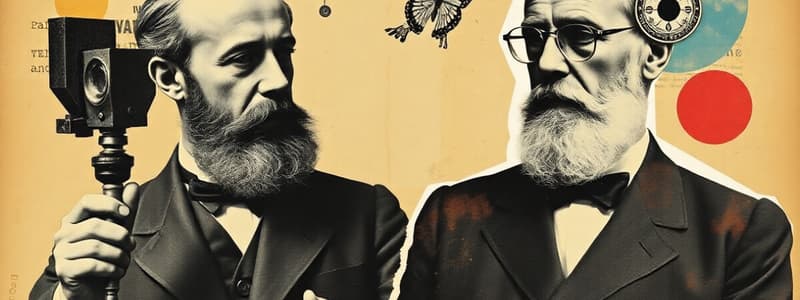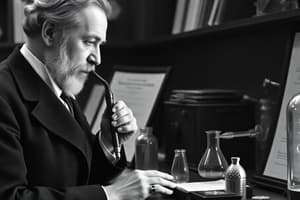Podcast
Questions and Answers
Which scientific advancement, attributed to Wilhelm Conrad Röntgen, directly led to a paradigm shift in medical diagnostics?
Which scientific advancement, attributed to Wilhelm Conrad Röntgen, directly led to a paradigm shift in medical diagnostics?
- The discovery of cathode rays and their properties.
- The development of serum therapy for bacterial infections.
- The identification of isotopes and their role in atomic structure.
- The observation of electromagnetic radiation capable of penetrating soft tissues. (correct)
Ivan Pavlov's research on canine digestive secretions inadvertently pioneered which fundamental concept in behavioral psychology?
Ivan Pavlov's research on canine digestive secretions inadvertently pioneered which fundamental concept in behavioral psychology?
- Classical conditioning based on associative learning. (correct)
- Social learning theory emphasizing observational learning.
- Operant conditioning through reinforcement and punishment.
- Cognitive dissonance theory involving mental conflict and attitude change.
Kitasato Shibasaburo's work on tetanus and diphtheria serum therapy directly demonstrated which immunological principle?
Kitasato Shibasaburo's work on tetanus and diphtheria serum therapy directly demonstrated which immunological principle?
- The concept of herd immunity through mass vaccination.
- The role of phagocytes in engulfing and destroying pathogens.
- The process of cell-mediated immunity involving T-lymphocytes.
- The principle of acquired immunity through antitoxins. (correct)
Jules Henri Poincaré's investigations into the stability of the solar system inadvertently laid groundwork for the development of which scientific theory?
Jules Henri Poincaré's investigations into the stability of the solar system inadvertently laid groundwork for the development of which scientific theory?
J.J. Thomson’s 'plum pudding model' of the atom was a direct consequence of his groundbreaking discovery of which subatomic particle?
J.J. Thomson’s 'plum pudding model' of the atom was a direct consequence of his groundbreaking discovery of which subatomic particle?
Prior to his professorship, Svante Arrhenius's academic journey at Uppsala University was primarily focused on which discipline?
Prior to his professorship, Svante Arrhenius's academic journey at Uppsala University was primarily focused on which discipline?
While both Wilhelm Conrad Röntgen and J.J. Thomson made pivotal discoveries, Röntgen's X-ray discovery is distinct from Thomson's electron discovery primarily because it directly impacted which field?
While both Wilhelm Conrad Röntgen and J.J. Thomson made pivotal discoveries, Röntgen's X-ray discovery is distinct from Thomson's electron discovery primarily because it directly impacted which field?
Ivan Pavlov's initial career aspirations significantly differed from his eventual scientific contributions in physiology. What was Pavlov's original intended profession?
Ivan Pavlov's initial career aspirations significantly differed from his eventual scientific contributions in physiology. What was Pavlov's original intended profession?
Kitasato Shibasaburo's serum therapy for tetanus and diphtheria is considered a cornerstone in the development of which broader medical field?
Kitasato Shibasaburo's serum therapy for tetanus and diphtheria is considered a cornerstone in the development of which broader medical field?
Jules Henri Poincaré's work on electromagnetism, though not as widely recognized as his chaos theory contributions, is noted for its influence on the development of which subsequent scientific theory?
Jules Henri Poincaré's work on electromagnetism, though not as widely recognized as his chaos theory contributions, is noted for its influence on the development of which subsequent scientific theory?
Flashcards
Wilhelm Conrad Röntgen
Wilhelm Conrad Röntgen
German physicist known for discovering X-rays in 1895.
X-rays
X-rays
Radiation that can pass through skin but not bones or metals, discovered by Röntgen.
Nobel Prize in Physics 1901
Nobel Prize in Physics 1901
Awarded to Röntgen for his discovery of X-rays, the first such recognition.
Ivan Pavlov
Ivan Pavlov
Signup and view all the flashcards
Classical Conditioning
Classical Conditioning
Signup and view all the flashcards
Kitasato Shibasaburo
Kitasato Shibasaburo
Signup and view all the flashcards
Chaos Theory
Chaos Theory
Signup and view all the flashcards
J.J. Thomson
J.J. Thomson
Signup and view all the flashcards
Electron
Electron
Signup and view all the flashcards
Isotopes
Isotopes
Signup and view all the flashcards
Study Notes
19th and 20th Century Scientific Progress
- Science became intimately linked to progress at the turn of the 20th century, with cutting-edge research driving crucial shifts in fundamental ideas.
- Discoveries abounded, and rules were rewritten at both subatomic and cosmological levels.
Wilhelm Conrad Röntgen
- German physicist Wilhelm Conrad Röntgen made a pivotal discovery: X-rays.
- This discovery occurred in 1895.
- X-rays were produced through electrically charged vacuum tubes, glowing fluorescent screens, and exposing photographic plates.
- The discovery impacted medicine and physics significantly.
- Röntgen won the first Nobel Prize in Physics in 1901, but he donated the prize money to research.
- He also contributed significantly to mechanics, thermodynamics, and electricity.
Ivan Pavlov
- Russian-born Ivan Pavlov, initially pursuing a religious career, switched to a scientific path.
- He specialized in physiology and became a professor in 1890 at the Military Medical Academy in St. Petersburg.
- Pavlov conducted research on the digestive secretions of dogs.
- Key discovery: dogs' learned to associate food with a bell.
- Dogs subsequently salivated to the bell, though no food was presented. This led to Pavlov's discovery of classical/Pavlovian conditioning.
- Pavlov received the Nobel Prize in Physiology or Medicine in 1904 for his work.
Kitasato Shibasaburo
- Japanese physician and bacteriologist Kitasato Shibasaburo studied in Tokyo and Berlin.
- Developed serum therapy to combat tetanus and diphtheria.
- In 1890, he isolated a serum containing antitoxin.
- This antitoxin was extracted from animals exposed to tetanus and provided immunity to the serum recipient.
Jules Henri Poincaré
- French mathematical physicist Jules Henri Poincaré.
- Noted for efforts to determine if the solar system is stable.
- Observing that tiny alterations in initial conditions can lead to significant, unpredictable changes in outcomes.
- His findings, including chaotic behavior, became an important underpinning for chaos theory in later decades.
- Key insights about the complex nature of systems.
J.J. Thomson
- English physicist J.J. Thomson was instrumental in describing atomic structure.
- Thomson identified "corpuscles" – later called electrons – through cathode ray tube experiments.
- These corpuscles carried a negative electric charge, far smaller than a hydrogen atom.
- Proposed the "plum pudding" model of the atom: positive charge dispersed throughout the atom, with electrons embedded within it like plums.
- Thomson also confirmed the existence of isotopes: chemically similar elements but with differing atomic weights.
Svante Arrhenius
- Svante Arrhenius studied physics at the University of Uppsala in Sweden.
- Eventually became a professor of physics at Uppsala.
- Studying the nature of elements and their chemical properties.
Studying That Suits You
Use AI to generate personalized quizzes and flashcards to suit your learning preferences.





